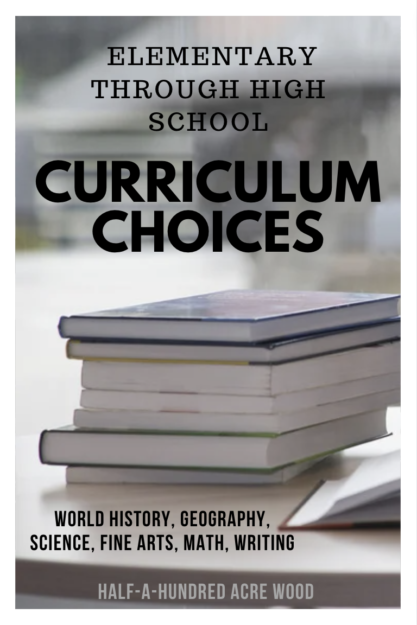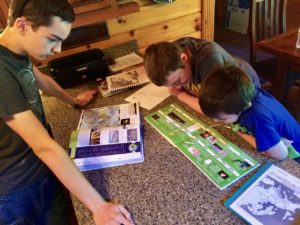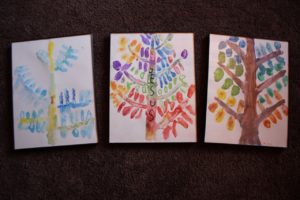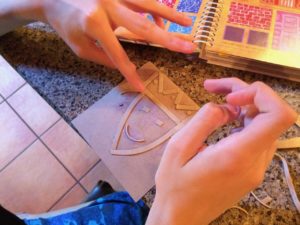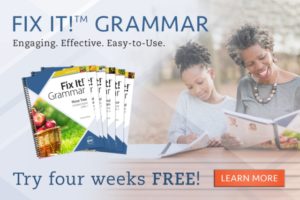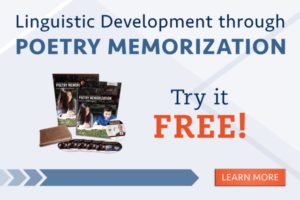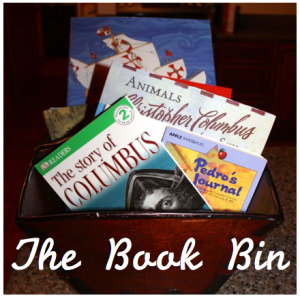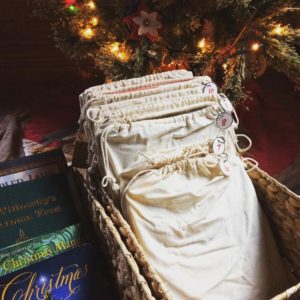It’s been a whirlwind of activity in our home this month! Our oldest son finished his first year of college, our youngest son finished up second grade, and our two middle sons have wrapped up their seventh and tenth grade years. It usually takes all summer for us to re-set and finalize curriculum selections, but this year everything seems to have fallen right into place!
Each of our children are so different, and customizing the learning experiences for our boys has become a great joy to me. Our children are not the same, so curriculum choices don’t look the same. God has a special calling for each of them, and we want to do everything we can to hone gifts and callings while our children also earn the credits required by our state. (And over the years, this process has become easier because we have waded through so.much.curriculum to find the material best-suited for our children.)
For the coming year, we still have a student at each level – elementary school, middle school, and high school. In a nutshell, what does this look like?
- Family Morning Time (encompasses read-alouds, history, science, geography, scripture, and fine arts)
- Individual Math for Each Student
- Individual Language Arts & Assigned Literature for Each Student
- Latin & Logic for Middle School
- Required Electives for High School
Because our family morning time covers so much ground in an efficient/effective manner (30-60 minutes total most days), it simplifies our overall schedule, especially for elementary and middle school. So… let’s just start with family read-alouds and morning time. Then we’ll highlight curriculum choices at each level and an example schedule. We still have not yet decided on individual literature selections, so we’ll be posting that a bit later this summer.
Family Morning Time & Read Alouds
We’ve studied history, religion, cultures, and geography through inspiring true stories of missionaries, and I can’t tell you how much these stories have impacted our lives!
For the past few years, we’ve explored the ongoing fulfillment of the Great Commission through a missions-focused curriculum that provides a complete three-year social studies and science program which integrates the study of scripture, history, geography, missions, hymns, and fine arts. The framework of the program is built around ordinary people whom God used in extraordinary ways. It is a foundation I wish I had had as a child, and it is one I am building now in my own heart alongside my children.
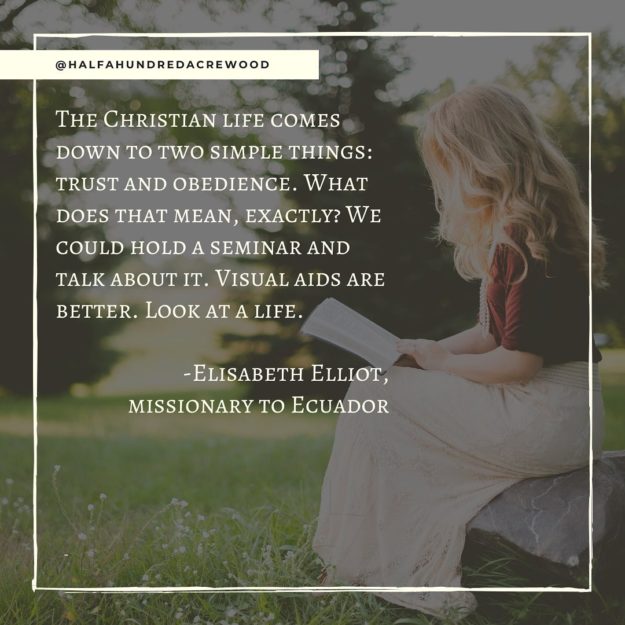
But why biographies? When my children face persecution, my desire is that they would remember two things: God’s Word (e.g.,scriptures that remind them that God will never leave them) and the “cloud of witnesses” that have gone before them. By reading about the love that Richard Wurmbrand extended to his torturers, or the joy of Jacob Deshazer upon remembering the Japanese, or the surrender of Charles Mulli to open his home to the street children of Kenya, we can reflect upon tangible examples of how God has worked through and strengthened the faith of our brothers and sisters in Christ – and we are also strengthened.
What does it mean to trust and obey? Look at a life. God empowered others. He will empower us. With that, here’s what we’re planning to read together in the coming school year.
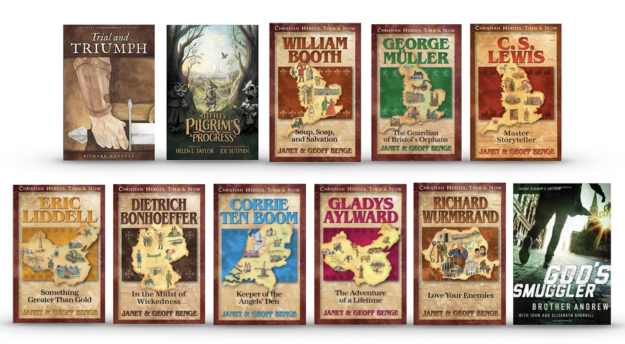
We’re repeating all of the stories we read three years ago while also reading a few new ones. (They are all so great that we can’t wait to re-read them!) Repeats include:
- Trial and Triumph: Stories from Church History (First Semester)
- George Müller: The Guardian of Bristol’s Orphans (Second Semester: Industrial Age)
- Eric Liddell: Something Greater Than Gold (Second Semester: World War I through World War II)
- Corrie Ten Boom: Keeper of the Angel’s Den (Second Semester: World War II)
- Gladys Aylward: The Adventures of a Lifetime (Second Semester: World War II and Communism)
- Richard Wurmbrand: Love Your Enemies (Second Semester: World War II and Communism)
- God’s Smuggler (Young Reader’s Edition) (Second Semester: Communism)
Our new read-alouds include:
- Beowulf by Michael Morpurgo
- Little Pilgrim’s Progress (First Semester)
- William Booth: Soup, Soap, and Salvation (First Semester: Industrial Age/Christmas)
- C.S. Lewis: Master Storyteller (Second Semester: World War I and beyond)
- Dietrich Bonhoeffer: In the Midst of Wickedness (Second Semester: World War II)
Our family read-alouds are taken from our Mission: Faith Forgers lesson plans. You can download a sample to see how it’s scheduled out here. If you happen to be a family using Classical Conversations, the books above would be great to read during Cycle 2.
Note: Our family listens to many audiobooks due to the amount of time we are in the car each week. To see a running list of everything we’ve read or are currently reading (during the calendar year 2022), click here.
Curriculum Choices: Elementary through High School
Over the past four years, we’ve enjoyed connecting as a family in a unified learning experience through our morning time. We all start together with morning time which takes up to an hour, part of which is over breakfast. This is our most special time, and our teenagers love to be a part of it. After that, our older students are fairly independent in their individual work and just ask questions as they need my assistance. After morning time, most of my day is spent on teaching reading, writing, and arithmetic (3rd grader), formal writing/editing (8th & 11th grader), and literature/history discussions (everyone).
Family Morning Time = Family Togetherness Time (aka, a One-Room Schoolhouse Approach)
Our family morning time begins with Mission: Faith Forgers which covers history, world geography/cultures/missions, science, and fine arts using our favorite curriculum choices for these subjects. We essentially took our favorite books for elementary through middle school and wrote lesson plans for reading through them (and doing associated activities) during our morning time. You can download a sample to see how it’s scheduled out here. For an overview and peek inside each of the resources in Mission Faith Forgers, check out the following video!
We’ve included a few reasons why we’ve picked each resource in Mission Faith Forgers below.
- For geography, The Usborne Geography Encyclopedia, Children’s Atlas of God’s World, Geography Audio Memory CD, and Window on the World. These books are our favorite geography resources which we use over a two-year period to memorize the countries of the world, learn about world cultures, and pray for other people groups and nations.
- For science, we’re using God’s Design for Physical Science (Inventions & Technology, Machines & Motion and Heat & Energy). We enjoy the God’s Design series because it is one of the simplest science programs to implement. It uses a hands-on approach to learning, the readings take less than 10 minutes, the experiments mostly use common household items, and the books include color illustrations and photos. Recently, Answers in Genesis stopped publishing the individual titles, so they are now only available as the triple-volume sets published by Masterbooks, which we now carry in our store. (Mission Faith Forgers uses Our Universe from God’s Design for Heaven & Earth, but we’ve decided to work through the entire volume of God’s Design for Physical Science this year since it’s our second time through Mission Faith Forgers AND our 8th grader can also complete a full physical science credit this year.)
- For history, we’re using The Story of the World Volume 3: Early Modern Times (From Elizabeth the First to the Forty-Niners) and The Story of the World Volume 4: The Modern Age (From Victoria’s Empire to the End of the USSR). Over our years of homeschooling, we’ve reviewed and/or used other history programs (including The Mystery of History, The World’s Story, From Adam to Us, and Diana Waring’s History Revealed) but we’ve kept returning to The Story of the World because of its narrative quality. It has not only been the best history for providing cultural stories from around the world, it is also one of the few programs that includes an audiobook option making it easier for homeschooling families to implement.
- We also incorporate an overview of church history using Trial & Triumph, God’s Timeline: The Big Book of Church History, and Torchlighters. This is the best part of the program, and all the art projects, hymns, and scriptures tie into the events and people studied. We even have Church History Notebooking Pages!
- For fine arts, we use step-by-step art projects which are included in the appendix, Then Sings My Soul for hymn study, and A Child’s Introduction to the Orchestra for classical music and orchestra/composer study. These have been absolute favorites in our home!
If you want to see what Mission Faith Forgers is like in action, refer to the top part of this post that includes photos and details about science, art, and other activities.
High School (Grade 11) – Curriculum & Literature
We front load the high school years in Grades 9 & 10 to open up the schedule for earning college credit through CLEP or dual enrollment when they get to their junior and senior years. So… our high schooler’s schedule is dwindling down (because he has already earned most of his high school credit diploma requirements) as he starts to work on his associates degree. (For more about Clepping for College Credit, click here.)
- Economics (1/2 credit) – Economics for Everybody | Download Free Lessons. We’re very much looking forward to trekking through this engaging exploration of economics. After this course, he will use CLEP® Principles of Microeconomics Book + Online to prepare for the CLEP test.
- Personal Finance (1/2 credit) – Foundations in Personal Finance.
- Physics (1 lab science credit) – Exploring Creation with Physics – 2nd Edition. We ordered a copy of Novare Introductory Physics and MasterBooks Physics only to find that they still pale in comparison to our tried and true choice, Exploring Creation with Physics. After all, Jay Wile’s explanations are what inspired our oldest to double major in chemistry and biology (and these science texts prepared him very well for his freshman year of college).
- English Composition (1 credit) – This is the one area we haven’t finalized yet, but the focus for composition will be on rhetoric (written speeches and oratory) because it’s the practical application of all the years of composition he’s completed. He will either use Fitting Words (which is excellent – you can read about it here), or Rhetoric Alive! Beyond that, he’s putting the finishing touches on his first novel which we hope to publish in the coming year.
- Math (1 credit) – Math U See Algebra 2. We switched everyone to Math U See in our home which has resulted in the best outcome of any option we have used in the past – for all of our children! Most math programs implement either too few math problems or too many. This program has a good balance, and it’s the only math course our three oldest sons have enjoyed.
- P.E. (1 credit) – Training for and running in 5K races in the coming year.
- Other Stuff: Our family loves Dave Raymond’s history so much that we plan to watch portions of Dave Raymond’s Christendom in the coming year because it overlaps much of what we’re studying in Mission Faith Forgers. We’ve been waiting for the release of this course for a couple of years now! Dave Raymond’s story-driven history curriculum follows an overarching theme of redemption throughout its history, provides a springboard for deep discussions with an upfront explanation of the Socratic method of asking questions (for both students and parents), and teaches and emphasizes how to take notes during lectures and how to build a portfolio that, at completion, may be used as a history textbook for younger children to read. Read our review of Dave Raymond’s American History which is similar in style and structure.
- Literature Selections. These selections may seem to overly emphasize nonfiction, but David has read so many works of {classic and modern} literature in his spare time that these selections round out what he normally reads – AND they follow along with what we’ll be doing in our family morning time. Instead of using regular comprehension literature guides, our family’s literature discussions follow the Teaching the Classics Approach. (We highly recommend Teaching the Classics for parents to learn how to discuss literature with their children!) Students can fill out a story chart for each work of literature this year while also practicing the art of narration.
- The Man Born to Be King by Dorothy Sayers
- Great Christian Classics Volume 1 (Augustine’s Confessions, St. Patrick’s Confessions, John Knox’s History of the Reformation in Scotland, Grace Abounding to the Chief of Sinners by John Bunyan, and Autobiography of John Paton)
- Beowulf by translated by Seamus Heaney
- Selected Canterbury Tales
- City of God by Augustine of Hippo
- Figures of Speech by Arthur Quinn (a compact reference for literary devices)
- Choice of Charles Dickens (Probably Hard Times, Great Expectations, or Oliver Twist)
- Hound of Baskervilles (with option of others from the Sherlock Holmes Treasury)
- Choice of C.S. Lewis (The Great Divorce, Mere Christianity, or Surprised by Joy)
- How Should We Then Live by Francis Schaeffer
- Amusing Ourselves to Death by Neil Postman
What the first two weeks of his lesson plans look like (Bible and spelling practice are write-ins):
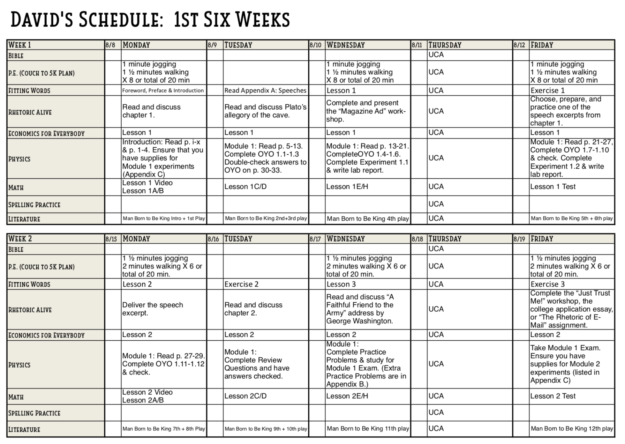
Middle School (Grade 8)
Our eighth grader’s science, fine arts, geography, and history work are taken primarily from Mission: Faith Forgers. Other subjects we incorporate at this level are Latin, Logic, English Composition, and Math.
- Family Morning Time – Mission Faith Forgers (history, church history, world geography, physical science, art, orchestra).
- Latin/Grammar/Vocabulary – Visual Latin II | Download 2 Free Lessons. You can read more about why we love Visual Latin here. Our third son will complete Visual Latin this year during middle school before heading into Spanish in high school. (He has wanted to work in construction since age 2, so Spanish Grammar from Latin Roots will be his high school level foreign language.)
- Using this in conjunction with Lingua Latina and the Lingua Latina Companion
- Logic – Introductory Logic. We have searched through many logic curricula, and this one is still our top pick. You can read all about it here.
- English Composition – Modern World History-Based Writing Lessons. This overlaps the history in Mission Faith Forgers with source texts on topics such as the printing press, the Age of Exploration, the French Revolution, Boer Wars, inventions of the Industrial Age, Wilson (World War I), Churchill (World War II), Sherlock Holmes, communism, and stories from modern world cultures. It incorporates nine structural units along with stylistic techniques and also includes vocabulary cards, literature suggestions, and access to helpful PDF resources. David used it three years ago, and it was fantastic! Also, because it’s the best {easiest, quickest, most effective} way to hone mechanics and editing skills, he will continue to use Fix It Grammar Level 3: Robin Hood. Read more about why we love this program so much!
- Math – Math U See Algebra I. We switched everyone to Math U See in our home which has resulted in the best outcome of any option we have used in the past – for all of our children! Most math programs implement either too few math problems or too many. This program has a good balance, and it’s the only math course our three oldest sons have enjoyed. And… because he started PreAlgebra in 7th grade, he will be capable of completing math through Calculus I in high school.
- Memory Work. Linguistic Development through Poetry Memorization. Try it free here!
- Literature Selections. Our middle-schooler’s literature selections will correspond roughly to history assigned in Mission: Faith Forgers (which is Trial & Triumph, Story of the World Volume 3 and Story of the World Volume 4). Instead of using regular comprehension literature guides, our family’s literature discussions follow the Teaching the Classics Approach. (We highly recommend Teaching the Classics for parents to learn how to discuss literature with their children!) Students can fill out a story chart for each work of literature this year while also practicing the art of narration.
- Otto of the Silver Hand by Howard Pyle
- The Canterbury Tales retold by Geraldine McCaughren
- When Lightning Struck: The Story of Martin Luther by Danika Cooley
- Isaac Newton: Inventor, Scientist, and Teacher by John Tiner
- A Christmas Carol by Charles Dickens
- The Secret Garden by Frances Hodgson Burnett
- Around the World in Eighty Days by Jules Verne
- Angel on the Square by Gloria Whelan
- Boy on the Wooden Box by Leon Leyson
- Children of the Storm by Natasha Vins
What the first two weeks of his lesson plans look like:
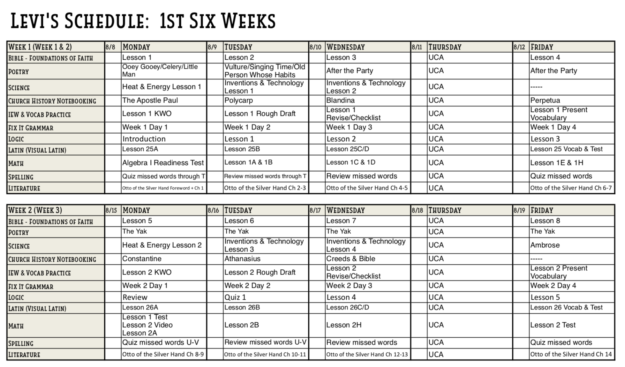
Elementary School (Grade 3)
- Family Morning Time – Mission Faith Forgers (history, church history, world geography, physical science, art, orchestra – all mentioned above). He’ll memorize all the countries of Europe and Asia this year!
- Memory Work. Linguistic Development through Poetry Memorization. Try it free here!
- Math. Math U See Gamma. We swapped to Math U See last year and suddenly he started understanding place value. He loves this program, and I love that he loves math now. (We’ll be starting the year off with a review of addition and subtraction facts with AIM for Addition and Subtraction before heading into Beta.)
- Reading & Spelling. All About Reading Level 3. We LOVE All About Reading. (Click here for why.) We’ll also use All About Spelling Level 3 for spelling instruction and dictation/practice.
- Penmanship. Script-n-Scribe Hymns in History (which reinforces the hymns and history in Mission Faith Forgers and automatically incorporates picture study).
- Composition. IEW Bible Heroes Writing Lessons – Includes free Teacher Edition ebook. He started this in the spring and has loved it! He’ll continue working through it next year.
- Grammar. Level 1: Nose Tree. We will work through these short, simple lessons at a slow pace to reinforce mechanics and editing skills over the course of the year. This is the quickest, most effective way to apply English grammar and mechanics. Read the reasons we love this program so much!
- Literature Selections. For our 3rd grader, we’ll be reading select titles from these favorite middle-ages-to-modern-times picture books and leveled readers using the “book bin” approach. We’ll also embark on some shared reading with our collection of Christian Biographies for Young Readers, along with the following shorter chapter books:
- Choice of medieval-themed books: The Minstrel in the Tower by Gloria Skurzynsk, The Sword in the Tree by Clyde Robert Bulla, or Knights of the Round Table by Gwen Gross
- Tales of Robin Hood by Tony Allan
- Louis Braille: The Boy Who Invented Books for the Blind by Margaret Davidson
- Choice of Stepping Stone Classics: The Three Musketeers, Les Miserables, Great Expectations, or Oliver Twist
- The Little Riders by Margaretha Shemin
- Twenty and Ten by Claire Hutchet Bishop
What the first two weeks of his lesson plans look like (picture/chapter books are write-ins):
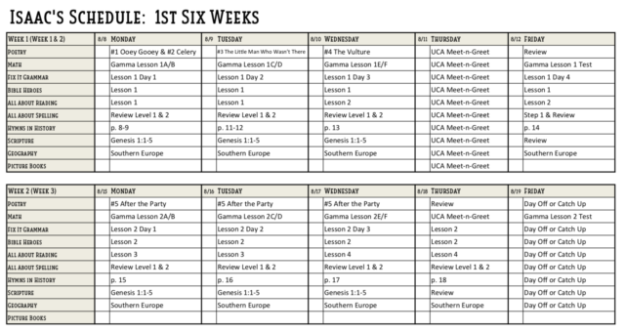
The Book Bin Approach: At the beginning of each week, fill a basket full of the books that you’re planning to read that week. For greater anticipation, you can store them in bags as we do for our Christmas book countdown!
Again, (even for the elementary age), instead of using regular comprehension literature guides, our family’s literature discussions follow the Teaching the Classics Approach. (We highly recommend Teaching the Classics for parents to learn how to discuss literature with their children!) Students can fill out a story chart for each work of literature this year while also practicing the art of narration.
Sample Homeschool Schedules
I thought I’d wrap this up by including a sample schedule here for the sake of others who would like to see a schedule. Our actual schedule deviates from this quite a bit for our older children. The only thing that remains consistent for everyone is our family morning time. Our older students choose the order in which they complete assignments, so one may be working on math while another is working on Latin. When I’m working with a student on writing/editing (IEW), his brothers are working on something they can do without my assistance so that they don’t interrupt.
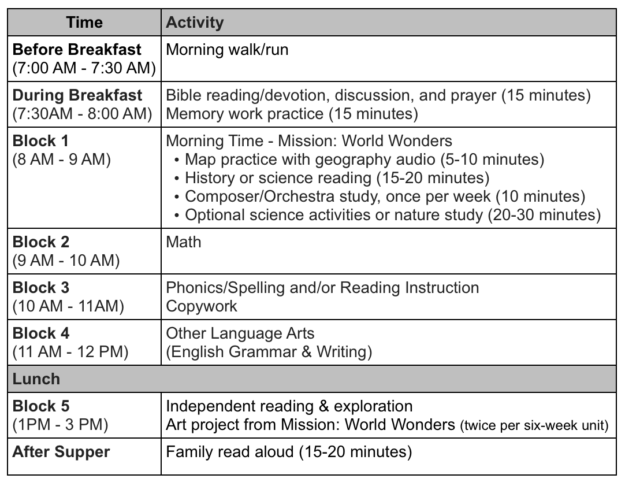
In a more simplistic format, here’s a rundown of what our core, bare-bones schedule sort of looks like (but Block 1 consists of our Mission Faith Forgers Morning Time instead of just Memory work and maps).

If you have any questions about this schedule, about any of our curriculum choices or literature selections, or about homeschool planning in general, feel free to give us a shout!

